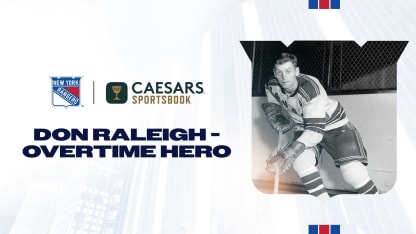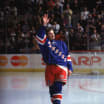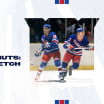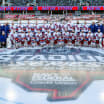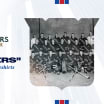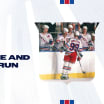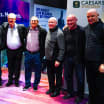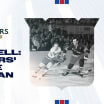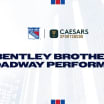When Don Raleigh made his first impression with the Rangers at the team’s Training Camp in his hometown of Winnipeg in 1943, Lester Patrick, the legendary Rangers’ General Manager and Head Coach, described Raleigh as “a jewel.”
Raleigh was just 17 years old during that Training Camp, but Patrick, as well as Frank Boucher (who was the Rangers’ Head Coach at the time), saw the potential he had. With the Rangers’ roster in transition as many of the team’s players left to serve in World War II, Raleigh, a center who was nicknamed “Bones” due to his slight frame (he was listed at 5’11” and 150 pounds), was in the team’s lineup for opening night of the 1943-44 season.
It was the start of a 10-season tenure for Raleigh with the Blueshirts. Over the course of his career, which exclusively took place during the Original Six Era, Raleigh became one of the most adept passers and puckhandlers in Rangers history.
Raleigh played in 15 NHL games as a teenager during the 1943-44 season, and became the youngest player to score a goal with the Rangers in franchise history – a distinction he still holds. Following the season, he spent one year in the Canadian Armed Forces and then two years at university. Early in the 1947-48 season, Raleigh rejoined the Rangers – much to the delight of Boucher, who by this time was also the team’s general manager in addition to head coach – and immediately made an impact.
Now 21 years old, Raleigh tallied two assists in his first game of the season on November 9, 1947 against Chicago. Then, a week later in his fourth game of the season against Montreal at MSG, Raleigh set an NHL record for the fastest three assists by one player, accomplishing the feat in a span of 81 seconds.
Prior to the 1948-49 season, Raleigh received a special honor. In the first 22 years of the franchise, only two players had worn jersey No. 7 for the Rangers – Boucher and Phil Watson. Watson’s playing career ended following the 1947-48 season, as he decided to retire and begin his coaching career in the Rangers organization with one of their farm teams, the New York Rovers.
Because of the legacy that Boucher and Watson created wearing that number, the organization wanted to ensure that whoever wore it next would be a player who would perform at a high level, possess a combination of class and determination, and be a Ranger for an extended period of time.
The answer was Raleigh.
“Bones” upheld that legacy, and his defining moment with the Rangers came during the 1950 Stanley Cup Final against the Detroit Red Wings. First, he tallied seven points (two goals, five assists) in the Rangers’ five-game series triumph over the Montreal Canadiens in the Semifinals, as he and his linemates, Pentti Lund and Ed Slowinski, drove the team’s offense and simultaneously limited the offensive production of the Canadiens’ Maurice Richard.
Through the first three games of the Stanley Cup Final, Raleigh had not tallied a point, and the Rangers entered Game 4 of the series trailing two-games-to-one. The Blueshirts were also facing an uphill battle in that the remainder of the series was going to be played in Detroit as a result of The Ringling Bros. and Barnum & Bailey Circus occupying MSG.
Game 4 was tied heading into overtime, as the Rangers rallied from a two-goal deficit in the third period. Nearly halfway through the extra session, Raleigh – known as more of a passer than a shooter – took a backhand shot from near the net that beat Red Wings goaltender Harry Lumley to win the game and tie the series for the Rangers.
Two nights later, Raleigh was the hero again. This time, after the Red Wings tied the game late in the third period to force overtime, the Rangers’ center ended the contest just 98 seconds into the extra session. Raleigh buried a rebound chance after Lumley stopped Slowinski’s initial shot to give the Rangers a 2-1 win and a three-games-to-two lead in the series.
With the goal, Raleigh became the first player in NHL history to score two overtime goals in the same Stanley Cup Final series. Raleigh’s heroics helped the Rangers get within one goal of winning the Stanley Cup. Although he also had a chance to get the game-winner for the Rangers in Game 7 of the series – and very nearly did so – the Red Wings won the series in double overtime.
Throughout the first half of the 1950s, Raleigh continued to perform at a high level and was one of the Rangers’ biggest offensive threats. He was named the team’s Most Valuable Player for the 1950-51 season, and in 1951-52, he was the inaugural recipient of the Frank Boucher Trophy, which was awarded annually to the Ranger who was considered the most popular player on and off the ice, as chosen by members of the Rangers Fan Club. In 1951-52, Raleigh also set a single-season franchise record at the time for assists with 42, and his 61 points that season were one shy of tying Boucher’s single-season franchise record.
In the mold of Boucher, Raleigh’s style on the ice – a playmaking center with a gentlemanly demeanor – kept him in contention for the Lady Byng Trophy for several seasons, and he was the runner-up for the award in 1953-54. The 1953-54 season was also the first of two seasons that Raleigh served as the Rangers’ captain.
Raleigh played his final game with the Rangers in 1955-56. By the end of that season, which was the 30th in franchise history, he had played in the third-most games as a Ranger, had tallied the third-most assists as a Ranger (only trailing the two players who had worn No. 7 before him, Boucher and Watson), and had registered the sixth-most points as a Ranger.
Raleigh’s back-to-back overtime goals in the 1950 Stanley Cup Final will forever be his shining moment as a Ranger. Those goals, however, only tell part of the story of one of the best Blueshirts in not only the Original Six Era, but also in the history of the franchise.

